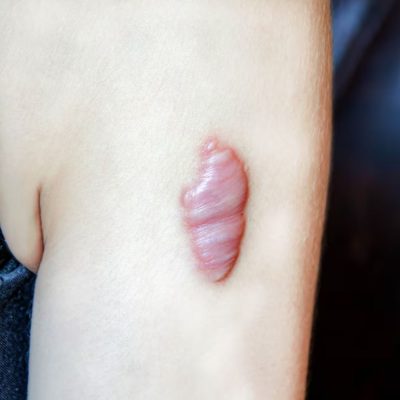Keloid Injections
Keloids are raised, thickened areas of scar tissue that form as a result of excessive collagen production during the wound healing process. These scars can be unsightly and sometimes cause discomfort, itching or pain. Keloid injection treatment is a targeted approach to reduce the size, appearance and symptoms of keloids, providing patients with improved functional and cosmetic outcomes.

What are Keloid Injections?
Keloid injections involve the direct administration of corticosteroids or other agents into the keloid scar to reduce its size and improve its appearance. The primary goal of this treatment is to soften and flatten the keloid, alleviating symptoms such as pain, itching and at times restricted movement. This minimally invasive approach is suitable for patients seeking non-surgical options for managing keloids.
Method & Treatment for Keloid Injection
Several types of injections can be used for keloid treatment.
Corticosteroid Injections
- Procedure: Corticosteroids are injected directly into the keloid tissue. These steroids help reduce inflammation, collagen production, and scar tissue formation, leading to a flattening of the keloid over time. Corticosteroids are the most common injection used for keloid treatments.
- Treatment Plan: The injections are usually administered every 4 to 6 weeks, depending on the size and response of the keloid. Multiple sessions may be required for optimal results.
5-Fluorouracil (5-FU) Injections
- Procedure: 5-FU, a chemotherapy agent, is sometimes combined with corticosteroids to enhance the treatment’s effectiveness. It works by inhibiting fibroblast activity, which is responsible for excessive collagen production in keloids.
- Treatment Plan: The injections are typically administered weekly, 5-FU injections can be used as an alternative or adjunct to corticosteroids.
Bleomycin Injections
- Procedure: Bleomycin, an anti-cancer medication, can be injected into keloids to disrupt fibroblast activity and collagen synthesis. This treatment is often considered for keloids resistant to other therapies.
- Treatment Plan: Injections are usually given every 2 to 4 weeks, with the number of sessions varying based on response to the injections.
Cryotherapy with Injections
- Procedure: Cryotherapy, which involves freezing the keloid with liquid nitrogen, can be combined with corticosteroid injections to enhance the flattening effect.
- Treatment Plan: The area is frozen before or after corticosteroid injection, typically in 3-week intervals.
Applied Areas for Keloid Injection Treatment
Keloid injections can be administered to keloids located in various areas, including:
Ears
Commonly occurs after ear piercings or surgery.
Chest & Shoulders
Often forms after acne, chickenpox, or trauma.
Neck & Jawline
Typically arises from shaving cuts or surgical scars.
Arms & Legs
Keloids in this area may result from vaccinations or trauma.
Precautions and Risks of Keloid Injection Treatment
- Not all keloids respond the same way to injections, and patient-specific factors such as keloid size, age and previous treatments are taken into consideration.
- Multiple sessions are often required and response to the injections should be regularly monitored to adjust the treatment plan as necessary.
- Avoid trauma or friction in the treated area as this can exacerbate keloid formation.
- Corticosteroid injections can sometimes cause thinning of the skin or subcutaneous fat (skin atrophy), leading to indentations.
- Changes in skin pigmentation (skin tone), particularly hyperpigmentation (darkening), may occur at the injection site.
- As with any injection, there is a slight risk of infection. Proper pre and post-treatment care minimizes this risk.
- Not all keloids respond completely to injection therapy. Some may recur or require additional treatments.
Note: Keloids by their very nature tend to recur, hence, close monitoring and multiple treatment sessions may be required.
Post-Procedure Signs to Look Out For
Redness & Swelling: Mild redness, swelling or tenderness at the injection site is common and usually subsides within a few days.
Temporary Discomfort: Some patients may experience temporary discomfort or mild pain after the injection.
Changes in Scar Appearance: Gradual softening and flattening of the keloid are expected over time, with multiple sessions often needed to achieve significant improvement.
Monitoring for Side Effects: Watch for signs of infection, skin thinning, or pigment changes and report these to your dermatologist promptly.
Complementary Cosmetic Procedures for Better Outcomes
Keloid injection treatment can be combined with other cosmetic procedures to enhance results and reduce the likelihood of recurrence:
Silicone Sheets or Gels:
Applying silicone sheets or gels after injections can help maintain flatness and reduce the risk of recurrence.
Pressure Therapy
For keloids on the ears, pressure earrings can be worn post-injection to help flatten the scar.
Microneedling Radio Frequency (MNRF)
When combined with steroid injections, MNRF can help break down keloid tissue and improve the overall appearance of the scar.
